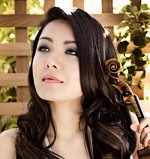Column Name
Title
In December 1977, Alec Hou, one of the first Chinese people to perform Western classical music after the Cultural Revolution, gave a sold-out concert in Shanghai. That same night, his wife, Yvonne, also a violinist, gave birth to their daughter, Yi-Jia Susanne Hou (B.M. ’00, Artist Diploma ’03, violin). Three years later, the couple gave up virtually everything to move to Canada and before long were regularly driving to New York City so their daughter could study with longtime Juilliard faculty member Dorothy DeLay (’42, violin).
Body
Now a busy soloist, Yi-Jia Hou found herself at a crossroads last summer. The Stradivari Society of Chicago had loaned her a 1735 Guarneri, but the loan was soon to end—before she’d had a chance to realize a dream of recording the Beethoven Violin Concerto on it. “I’d wanted to make this recording as a tribute to freedom of expression across the world—and to realize the dream my parents couldn’t,” she told first-year pianist Angie Zhang. “I saw this dream slipping away, and in despair I spoke with mentors and friends, and then all of a sudden, the wheels started turning.”
Hou got an extension of several months on the Guarneri; asked a friend, design consultant Lorenz Ehrsam (B.M. ’88, M.M. ’90, piano), to manage the project; convinced the London Symphony Orchestra to take it on; and found a producer, a conductor, a place to record, and a Parisian designer to make her a dress. It was, she said, “the craziest time in my whole life,” but the recording and a related documentary are underway now.
Journal writer Zhang met Hou because of one the violinist’s other ventures—she’s the creator and artistic director of DreamArts Showcase, a young artist competition in which Zhang, third-year violinist Hahnsol Kim, and cello doctoral candidate Meta Weiss were finalists; they performed in a Princess Cruises showcase in December.
Did Juilliard change your outlook as a performer?
My teachers at Juilliard—DeLay, Cho-Liang Lin (Pre-College ’77; Diploma ’81, violin), and Naoko Tanaka (Diploma ’76, Postgraduate Diploma ’77, violin)—were more than just teachers, they were life and career mentors. What Juilliard did for me was not simply train me to be the best—or, as I like to say, most genuine—artist and musician, but to think in the way that an artist must in order to contribute something of value to our world.
Has the classical music scene changed since you were at Juilliard?
Absolutely! Artists today are creating cross-platform, multidisciplinary forms of expression and giving performances in new and unexpected places. And in many ways the art world has changed as a result of iTunes, iPhones, and social media. There are virtual worlds and fast access to music and film and the arts everywhere, making the dire need for real connections. It’s simultaneously an exciting and dangerous environment to be an artist—you can do so much so quickly, but you can also lose yourself in the process.
What advice do you have for finding and managing projects?
Sometimes opportunities can be sought; others must come to you. There’s no formula, and it is not always soon or immediate; however, when that day of opportunity comes, you’ll know it. Nothing truly great and worthwhile comes easily, though.
Do you think being an artist and an entrepreneur are compatible?
Not at all—find a business partner! Nothing is compatible with being an artist—it’s all-consuming and an unending journey in the pursuit of excellence and perfection (which is entirely unattainable, but we continue to try harder every day). I’m only half-kidding, but there are there are many ways in which the artistic process of constantly reinventing ourselves is not unlike being an entrepreneur.
What are some of the overlaps?
Both require consistency, authenticity, and differentiation—nothing gets done without incredible hard work and perseverance—all skills that artists possess plentifully. The same way we take one phrase and practice it over and over again until it’s perfect and then proceed to refine every detail, and research the composer and the work to find our own voice and interpretation—these are all similar to what needs to be done to bring a new product or company into the world. Consider all the angles, do your research, then keep working at it until it’s done. If you do that, you can really do anything.





